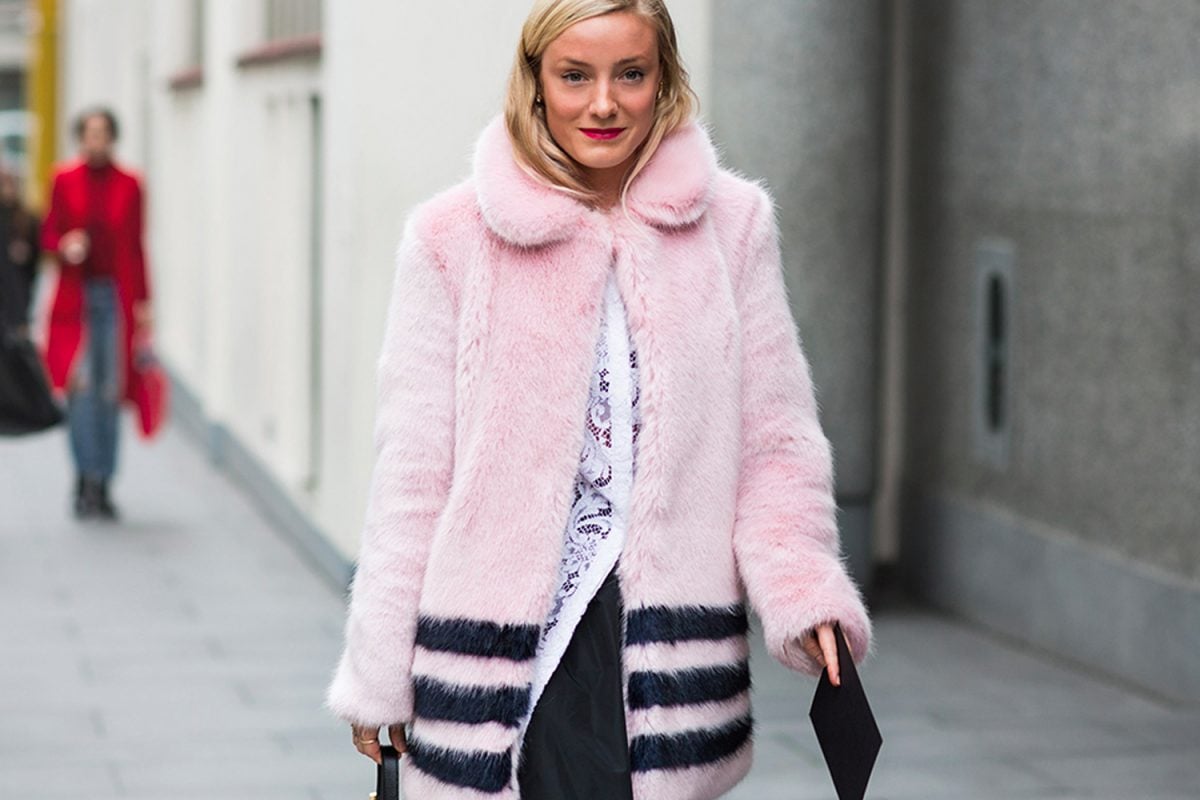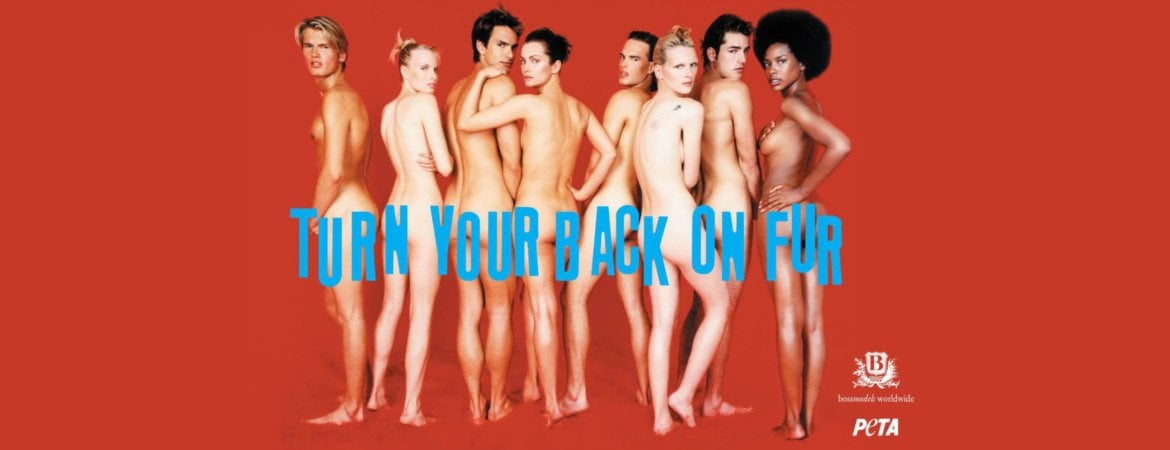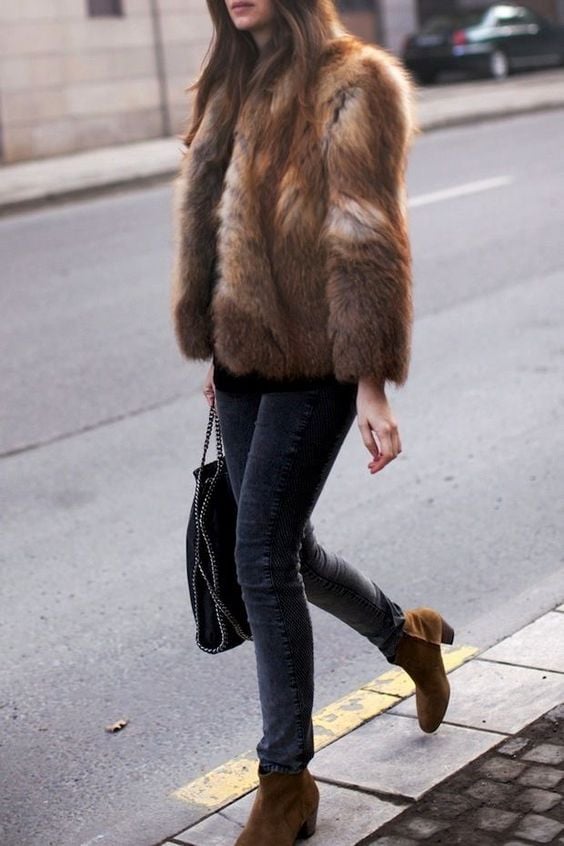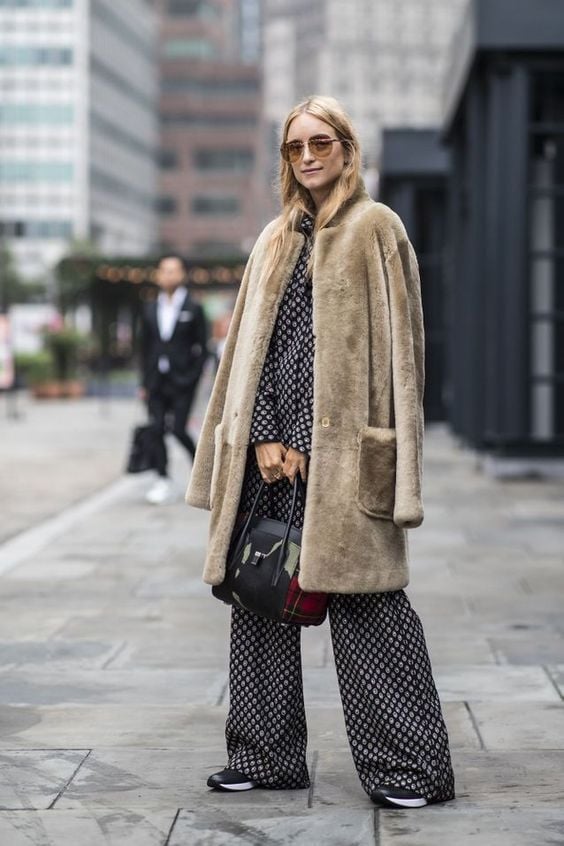
Why is wearing faux fur a controversial act?
This publication is also available in: Français
English (UK)
Deutsch
Italiano
Español
Now more than ever, faux fur is trendy.
On the runways, in ready-to-wear stores, and on the streets, puffy coats, furry-looking jackets, and other accessories made from faux animal skins are everywhere. So much so that we no longer even question what we put on our backs.
Wearing faux fur gives us a sense of awareness. By donning a synthetic fur scarf, an oversized puffy coat, or a jacket with a vegan fur collar, we help prevent the fur industry from progressing.
So, if killing animals for clothing is no longer a normalized act, what should we think of the currently most fashionable alternative, animal fur imitation?
Is it, therefore, the miracle solution to the animal skin market?
Answers in this article.
Animal Fur: Evolution of a Controversial Textile
Originally, when wearing a dead animal was the norm
As far back as humans have known how to hunt, fur has existed. In prehistoric times, humans would collect the fur of their prey once hunted. Every part of the beast was reused for survival purposes. For example, the animal’s skin was used for protection against the cold. It had a purpose.
But the world has evolved, and society was born. Man lost his primitive role to conform to societal norms. And fur did not escape fashion and its rules. Over the centuries, it became a symbol of wealth and power. In the 1970s, it entered Hollywood to embody elegance and exuberance for anyone willing to wear it.
Despite the protests against it, fur continued to persuade designers and their loyal followers, as until 2015, 70% of fashion labels showcased fur in their runway shows.
Evolution of Consciousness and Limits of a Market
In light of the exploitation conditions and treatment of real animal furs, collective consciousness has evolved. Because if just a few years ago, wearing a dead animal on one’s back was seen as a sign of wealth and social distinction, today, it is a cruel, even repugnant act.
And this paradigm shift could not have occurred without the involvement and bold actions of the international organization PETA (People for the Ethical Treatment of Animals). In 1990, a campaign garnered significant attention and shook the industry. The ad featured supermodels of the time posing nude with the impactful slogan “I’d rather go naked than wear fur” (I prefer to stay naked than wear fur).

At the same time, the cruelty associated with the exploitation and transformation of animals to obtain a mink coat or a fox scarf has posed moral limits that consumers could no longer accept.
But it was in 2017, just 5 years ago, that things changed. That year, Gucci decided to no longer use animal fur for its collections. This announcement had a snowball effect, as other houses followed suit. As Arnaud Dubois of Ecopel confirms, “For me, there is a before and an after Gucci, because the anti-fur effect is becoming the norm.”
All of this has opened the door to the reality of the fur industry and made way for other forms of textiles serving as alternatives to animal skin in fashion.
Faux Fur Designed as an Alternative
The commitment of pioneering brand Stella McCartney has contributed to the boom of alternatives to real animal fur. Since launching her label in 2001, she has always followed her convictions and excludes the use of exotic skins, feathers, leathers, and furs in her collections.
The gradual withdrawal of the fur industry by high fashion houses has also allowed the fashion sphere to take a 90-degree turn, offering a prime place to vegan furs. The most recognized labels like Gucci, Versace, and Prada have gradually followed those who had already taken a stand against animal exploitation in fashion.
It should also be noted that technological innovation has allowed faux fur to take on a new, more modern form, but also a more realistic one (almost too realistic), soft, and fluffy. Indeed, vegan fur has never been more lifelike than today.
Ultimately, the transition to faux fur did not happen overnight. On the contrary, it is a process that has taken time and has resulted in a snowball effect in the fashion sphere, coupled with a collective awakening among consumers.
Wearing Faux Fur: An Ecological Question
For many, the faux fur option is the choice to prioritize when wanting to wear clothing that closely resembles real animal skin. And it’s true, but it seems that fashion pieces made from synthetic fibers are not without their issues, especially when ecological arguments show us that we would be better off not buying them.
So, is faux fur our ally in limiting the advance against real fur?
Firstly, we can start by saying that faux fur pieces are not only found at major ethical designers. Indeed, they are not just high-end creations made from labeled and traceable fibers or vegan textiles. Coats, jackets, and other accessories in “faux fur” are also found at H&M, Primark, or Shein. In this case, we are in a context of overproduction that encourages the popularization of fast fashion.
Next, we can look at the very composition of faux fur. What primarily makes up synthetic fur is polyester or acrylic, which are derivatives of petroleum. The resources needed to produce them are particularly energy-intensive, contributing to deforestation.
And petroleum means plastic fibers, which in turn pose problems regarding durability and recycling.
In short, faux fur is not ecologically responsible. It resembles a traditional garment produced en masse, and its impact has consequences for the environment.
But, it is not just that.
But Also an Ethical Alternative
In a Modalova interview, Arnaud Dubois, the communications manager at Ecopel, a Franco-Chinese company that produces luxury faux fur, explains that choosing faux fur is primarily ethical, not ecological. “If you are a brand and you want to use fur, choose faux fur; it’s better not to kill animals. If you want to be 100% ecological, use linen or hemp instead, as synthetic materials are not ideal.”
Faux fur is polluting. It has an ecological impact. However, in its production, it attempts to solve a significant ethical problem: the reduction of the number of animals raised, confined, skinned, and dismembered for the sole needs of the fur industry that recovers the skin to make coats, jackets, scarves, pom-pom hats, and other accessories.
Saving the lives of millions of animals is, therefore, the main issue of the alternative to fur. And with the influence of NGOs, public opinion, and advancements in research and development, major players in the fashion sector are also turning towards “no-fur.” To date, no fewer than 40 labels have renounced animal fur, with the latest being Moncler and Dolce & Gabbana.


Conclusion: Is Wearing Faux Fur a Controversial Act?
Faux fur is not ecological, but it is ethical. It doesn’t meet all the criteria, but it has the merit of saving the lives of millions of animals.
Should we blame faux fur for that?
It depends on where we set the bar. Some may say, what’s the point of replacing one product with another that will cause even more harm to the planet, while others may argue that it’s already a commendable alternative.
However, while researching for this article, a phrase cited by a speaker from the Kering group resonated: “The goal is not to constrain, but to convince.” It is important to give consumers and brands the choice so that everyone can gradually reclaim faux fur. And that choice indeed involves offering these alternatives, which, even if they are not perfect today, pave the way for a new dynamic.
The fur industry is still in transition. Brands coexist with petrochemicals to move towards tomorrow. Innovations are here, and research and development continue to progress in favor of increasingly bio-based, sustainable, and organic textiles. It remains only to convince brands to move in this direction.
As Ecopel witnesses, they are working on developing four more virtuous textile fibers, namely Gatcha, recycled fibers, Kanekaron, or a 100% plant-based fiber made from corn.
💡 To delve deeper into the subject of ethical fashion:
Sustainable fashion: how to consume it?
Eco-responsible luxury brands: 5 labels to know
Image on the cover: © Sandra Semburg



